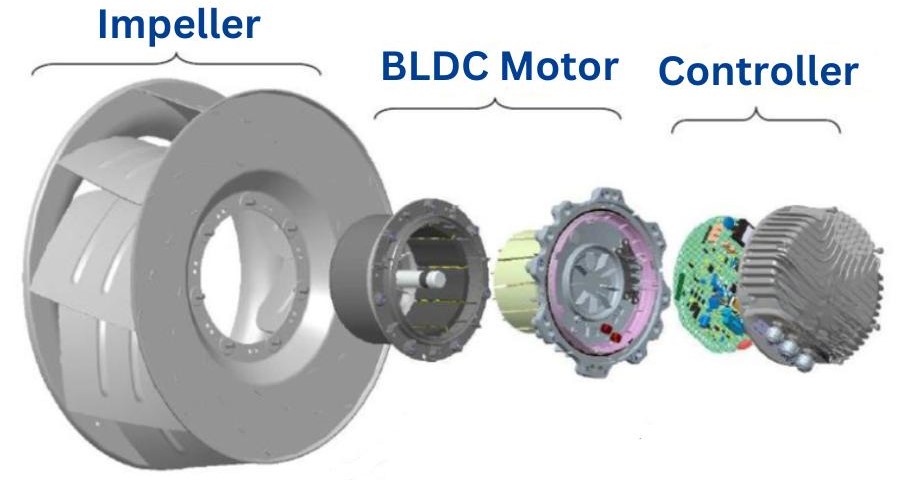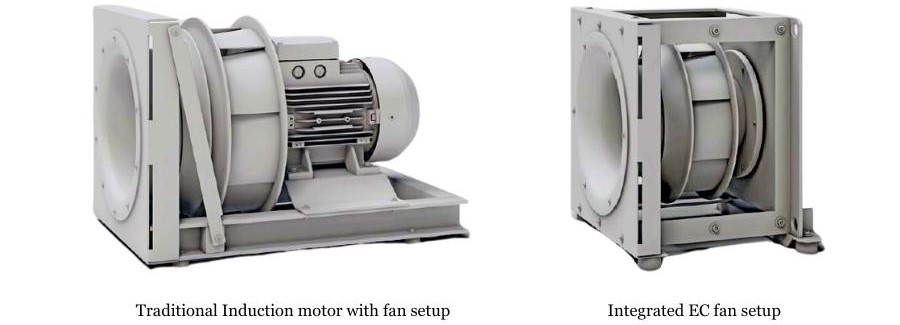EC FANS : BLDC Motors
Ujjwal Bhola2024-03-30T07:12:03+00:00Understanding EC Fans
EC fans, short for Electronically Commutated fans, are a significant advancement in the air circulation technology. Unlike the AC fans, which operate at fixed speeds, the EC fans use brushless DC motors (BLDC motors) with integrated electronics inside the design itself. This integrated technology allows for precise control over fan speed and airflow, resulting in great energy efficiency and performance optimization.
The BLDC motor in the EC Fan can adjust its speed according to the requirement of the situation at any particular time. This minimizes power consumption, leading to significant cost savings and environmental benefits.Their customizable performance and quiet operation make them ideal for a wide range of applications, from industrial settings to residential spaces in HVAC Industry.

How does an EC Fan Work?
The working principle of an EC fan involves different key components.The main constituent is the Brushless DC (BLDC) motor, which is controlled by integrated electronics to regulate the speed and airflow. Here’s a simplified breakdown of how an EC fan operates:
- BLDC Motor: The BLDC motor consists of a rotor and a stator. Permanent magnets in the rotor produce a magnetic field which is required for full load production. BLDC motors have a brushless design and operate on feedback and supplied signals. The BLDC motor used in EC fans is generally an outrunner type.
- Electronic Control Unit (ECU): The ECU, also known as the motor controller is integrated in the motor itself. It receives input signals, such as speed commands or sensor feedback, and adjusts the power supplied to the motor accordingly.
- Sensor Feedback: Many EC fans have different sensors, such as Hall effect sensors to provide feedback on parameters like rotor position or speed.
- Speed Control: The ECU regulates the speed of the BLDC motor over a wide range by adjusting the timing and duration of the electrical pulses sent to the motor windings.
- Airflow Generation (Fan): As the BLDC motor rotates, it drives the fan blades to produce airflow. The speed and torque of the motor determine the volume and pressure of the airflow generated by the fan. In modern EC fans the blades are mounted on the body of the motor itself, making it compact and rugged.
Innotec Power: BLDC Motor Manufacturer for EC Fans
Innotec Power is a leading manufacturer of Permanent Magnet based BLDC motors for Global OEMs. Our range of motors are designed to easily integrate and work with different VFDs (Variable frequency drive) and inverters making them variable speed motors. These variable speed motors are optimized to work as an EC fan motor. Depending upon the client’s requirement, there are a range of frameless motors that can be integrated with a fan and ECU completing the whole assembly. Working with Innotec, gives OEMs the opportunity to customize the mechanical and electrical features of the motor according to their speed & torque requirements.
Get in touch with us to discuss more about custom BLDC motors & Frameless motors. Check out our wide range of standard BLDC motor offerings:
Difference between AC motor and EC motor
AC motors use the regular power from the outlet to spin and need an extra device called a frequency converter to adjust how fast they spin. On the other hand, EC motors are different. They don’t have brushes and use magnets to work. They also have special electronics built inside to manage how much power they use and how fast they spin. This makes EC motors very efficient, which means they can save a lot of energy. They are also very quiet because they don’t vibrate much. This quietness helps them last longer.
EC motors are easy to control because of the electronics inside them. You can connect them directly to things like knobs, voltage signals, or other devices. They even have a special feature called PID control that lets them adjust themselves based on pressure, which is useful in some systems.
Using EC motors can save money on installation because they already have safety features built-in. You don’t need extra things like thermal protectors, relays, or fancy cables. This makes them simpler and cheaper to set up.

Applications of Electronically Commutated Fans
- HVAC Systems: EC fans are always preferred over any other fan in the HVAC industry due to its high efficiency, speed control and light weight.
- Refrigeration Units: The AHU system in big refrigeration units commonly see EC motors installed as it saves space & makes the whole system compact.
- Data Centers: The quiet operation of EC fans make it a great choice for data centers and offices.
- Industrial Ventilation: In mass manufacturing units where the duty cycle is continuous 24/7, small savings can produce big impacts. Opting for efficient EC fans in the ventilation system the OPEX can be reduced by big margens.
- Greenhouses and Agriculture: In farms and greenhouses EC motors are used for AHUs, HVAC systems and cooling towers, etc.

